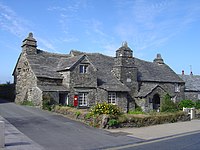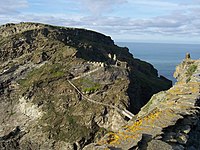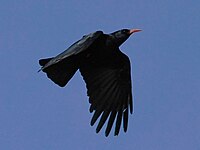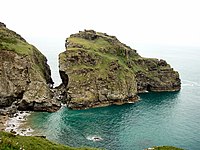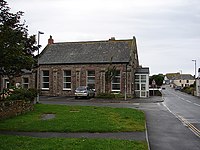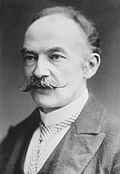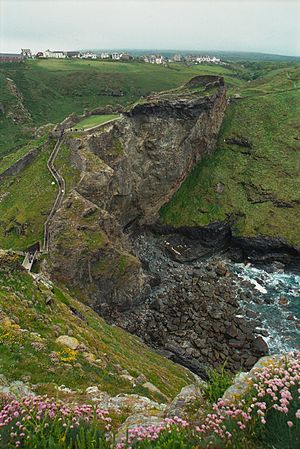Tintagel
| Tintagel Cornish: Tre war Venydh | |
| Cornwall | |
|---|---|
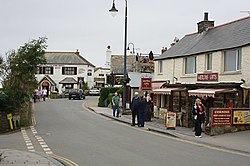 Fore Street, Tintagel | |
| Location | |
| Grid reference: | SX057884 |
| Location: | 50°39’47"N, 4°45’0"W |
| Data | |
| Population: | 1,820 (2001) |
| Post town: | Tintagel |
| Postcode: | PL34 |
| Dialling code: | 01840 77 |
| Local Government | |
| Council: | Cornwall |
| Parliamentary constituency: |
North Cornwall |
Tintagel is a village on the Atlantic coast of Cornwall. The population of the parish is 1,820 people, and the area of the parish is 4,281 acres.[1]
On the coast at the village is Tintagel Island, linked by an isthmus and wooden footbridge, on which stands the ruins of Tintagel Castle. On the mainland side is an impressive gatehouse fort. The village and Tintagel Castle are associated with the legends surrounding King Arthur and the knights of the Round Table. The village has, in recent times, become attractive to day-trippers, and tourists from many parts of the world, and is one of the most-visited places in Britain.[2] The Arthurian connection alone has ensure a constant stream of visitors and a series of bizarre themed shops and displays in the village.
The village also contains the 'Old Post Office', which dates from the 14th century. It became a post office during the nineteenth century, and is now listed Grade I and owned by the National Trust.
Contents
Name
Toponymists have had difficulty explaining the origin of 'Tintagel': the probability is that it is Norman French as the Cornish of the 13th century would have lacked the soft 'g' ('i/j' in the earliest forms: see also Tintagel Castle). If it is Cornish then 'Dun' would mean Fort. Oliver Padel proposes 'Dun' '-tagell' meaning narrow place in his book on place names.[3] There is a possible cognate in the Channel Islands named Tente d'Agel, but that still leaves the question subject to doubt.[4]
The name first occurs in Geoffrey of Monmouth's Historia Regum Britanniae (c. 1136, in Latin) as Tintagol, implying pronunciation with a hard [g] sound as in modern English girl. But in Layamon's Brut,[5] in early Middle English, the name is rendered as Tintaieol. The letter i in this spelling may imply a soft consonant like modern English j; the second part of the name would be pronounced approximately as -ageul would be in modern French.
An oft-quoted Celtic etymology in the Oxford Dictionary of English Place-Names,[6] accepts the view of Padel (1985) that the name is from Cornish *din meaning fort and *tagell meaning neck, throat, constriction, narrow (the Modern Welsh tagell for "gill" or "wattle".
Tintagel, Trevena and Bossiney
The modern-day village of Tintagel was known as Trevena until the Post Office started using 'Tintagel' as the name in the mid 19th century; until then Tintagel had been restricted to the name of the headland and of the parish. 'Trevana' is from the Cornish Tre war Venydh; 'Village on a Mountain'.
Arthurian Myth
In Geoffrey of Monmouth's Historia Regum Britanniae (c. 1136), Gorlois Duke of Cornwall puts his wife Igraine in Tintagol while he's at war (posuit eam in oppido Tintagol in littore maris: "he put her in the oppidum Tintagol on the shore of the sea"). Merlin disguised Uther Pendragon as Gorlois so that Uther could enter Tintagol and know Igraine, who thought him her husband. Thus Uther fathered King Arthur on her.
Tintagel is also used as a locus for the Arthurian mythos by the poet Alfred, Lord Tennyson in the epic poem cycle Idylls of the King.
History
The Ravenna Cosmography, of around 700, makes reference to Purocoronavis, (almost certainly a corruption of Durocornovium), 'a fort or walled settlement of the Cornovii': the location is unidentified, but Tintagel and Carn Brea have both been suggested, although the suggestion of Cornovii in Cornwall is no more than conjecture; they were a Midland tribe.
In Norman times a small castle was established at Bossiney, probably before the Domesday Survey of 1086; Bossiney and Trevena were established as a borough in 1253 by Richard, 1st Earl of Cornwall. In Domesday Book there are certainly two manors in this parish (and a probable third; Trethevy). Bossiney (which included Trevena) was held from the monks of Bodmin by the Earl of Cornwall: there was land for 6 ploughs and 30 acres of pasture. Before the Conquest it had been held from the monks by Alfwy. The monks of Bodmin held Treknow themselves: there was land for 8 ploughs and 100 acres of pasture.[7]
Tintagel was one of the 17 Antiqua maneria of the Duchy of Cornwall.[8] The parish feast traditionally celebrated at Tintagel was October 19, the feast day of St Denys, patron of the chapel at Trevena (the proper date is October 9 but the feast has moved forward due to the calendar reform of 1752). The market hall and the site of the fair were near the chapel.
The Borough of Bossiney was given the right to send two MPs to Parliament from around 1552 and continued to do so until 1832 when its status as a borough was abolished. The villages of Trevena and Bossiney were until the early 20th century separated by fields along Bossiney Road.
The Tithe Commissioners' survey was carried out in 1840-41 and recorded the area of the parish as 4,280 acres, of which arable and pasture land was 3,200 acres. The land owned by the largest landowner, Lord Wharncliffe, amounted to 1,814 acres, and there were 125 acres of glebe land. Precise details of the size and tenure of every piece of land are given.[9][10] Sidney Madge did research into the history of the parish and compiled a manuscript Records of Tintagel in 1945.[11]
On 6 July 1979, Tintagel was briefly subject to national attention when an RAF Hawker Hunter fighter aircraft crashed into the village following an engine malfunction.[12] The unusual incident caused significant damage and consternation, but no deaths.
Treknow is the largest of the other villages and hamlets in the parish, which include Trethevy, Trebarwith, Tregatta, Trenale and Trewarmett.
Archaeology and architecture
Excavations
Major excavations beginning with C A Ralegh Radford's work in the 1930s on and around the site of the 12th-century castle have revealed that Tintagel headland was the site of a high status British monastery (according to Ralegh Radford) or a princely fortress / trading settlement dating to the 5th and 6th centuries (according to later excavators), in the period immediately following the withdrawal of the Romans from Britain. Finds of Mediterranean oil and wine jars show that Sub-Roman Britain was not the isolated outpost it was previously considered to be, for an extensive trade in high-value goods was taking place at the time with the Mediterranean region.[13] Finds from the excavations are preserved at the Royal Cornwall Museum in Truro. In 1998, excavations discovered the "Arthur stone" which has added to Tintagel's Arthurian lore though historians do not believe the inscription refers to King Arthur himself. Two seasons of excavation work were undertaken in Tintagel churchyard in the early 1990s.[14]
Antiquities
The largest of the Bronze Age barrows is at the highest point in the parish, Condolden, another is at Menadue, and there are a number of others along the cliffs. In the Iron Age there were probably fortifications at Willapark and Barras Head, and inland at Trenale Bury. Two of the Roman milestones found in Cornwall are at Tintagel (the earlier of the two is described under Trethevy): the later one was found in the walls of the churchyard in 1889 and is preserved in the church. The inscription can be read as '[I]mp C G Val Lic Licin' which would refer to the Emperor Licinius (d. 324).[15][16]
There are many other relics of antiquity to be found here such as the so-called King Arthur's Footprint on the Island and a carved rock from Starapark which has been placed outside the Sir James Smith's School at Dark Lane, Camelford. Rodney Castleden has written about these as Bronze Age ritual objects.[17] "King Arthur's Footprint" is a hollow in the rock at the highest point of Tintagel Island's southern side. It is not entirely natural, having been shaped by human hands at some stage.[18] It may have been used for the inauguration of kings or chieftains as the site is known to have a long history stretching back to the Dark Ages. The name is probably a 19th-century invention by the Castle guide.
Stone crosses, of which there are two, have both been moved from their original positions: the plainer of the two is described under Bossiney. Aelnat's cross which was found at Trevillet and then moved to Trevena, is finely carved. The inscription can be read as 'Aelnat fecit hanc crucem pro anima sua' (Ælnat made this cross for [the good of] his soul) (the back of the stone has the names of the four evangelists): the name of this man is Saxon (together with Alfwy mentioned in 1086 he is the only Anglo-Saxon recorded in connection with the area).[19][20]
Notable secular buildings
The main buildings of interest are Tintagel Castle on Tintagel Island and Tintagel Old Post Office in the village itself.
Tintagel Primary School was built at Treven in 1914 to replace the old church school (founded 1874) and has been extended since. Those who go on to a comprehensive school attend Sir James Smith's School, Camelford.[21] The Gift House was purchased by the Trustees of Tintagel Women's Institute in 1923 from Catherine Johns. It adjoins the Old Post Office.
The former Vicarage was built in the early 17th century and substantial additions were made in the late 18th and mid 19th centuries. In the grounds is Fontevrault Chapel[22] and a dovecote or 'columbarium' which is one of the best preserved in Cornwall.[23] In 2008 the Diocese of Truro decided to acquire new accommodation for future vicars and to sell the vicarage,[24] though the site and glebe lands were the home of the vicars as early as the mid 13th century when the benefice came into the hands of the Abbey of Fontevraud in Anjou, France.[25]
King Arthur's Hall
King Arthur's Hall at Trevena is an impressive building of the early 1930s.[26] It was built for Mr F T Glasscock as the headquarters of the Fellowship of the Knights of the Round Table, behind Trevena House. A variety of Cornish stones are used in the construction and the 73 stained glass windows illustrating the Arthurian tales are by Veronica Whall; there are several fine paintings also of scenes from the life of King Arthur by William Hatherell.[27]
In 1927, the Order of the Fellowship of the Knights of the Round Table was formed in Britain by Frederick Thomas Glasscock (a retired London businessman, d. 1934)[28] to promote Christian ideals and Arthurian notions of mediæval chivalry.[29] Glasscock was resident at Tintagel (in the house "Eirenicon" which he had built) and responsible for the building of King Arthur's Hall (an extension of Trevena House which had been John Douglas Cook's residence and had been built on the site of the former Town Hall and Market Hall).[30] The hall is now used as a Masonic Hall, and is home to four Masonic bodies:
- King Arthur Lodge No. 7134 which was warranted on 13 November 1951;
- St Enodoc Lodge No. 9226 which was consecrated on 30 May 1987;
- King Arthur Royal Arch Chapter No. 7134 which was consecrated on 31 March 1962;
- Tintagel Castle Lodge of Mark Master Masons No. 1800 which was consecrated on 23 April 1999.[31]
Churches and chapels
Church of English parish church
The parish church is St Materiana. It was built in Norman times (was a late mediæval tower). Nikolaus Pevsner (writing in 1950) is uncertain about the dating and suggests that the Norman work has some Saxon features, while the tower may be 13th or 15th century in date.[32][33][34] It stands on the cliffs between Trevena and Tintagel Castle and is listed Grade I.[35]
The first church on the site was probably in the 6th century, founded as a daughter church of Minster: these are the only churches dedicated to the saint though she is usually identified with Madryn, Princess of Gwent.[36] The existing church may be late 11th / early 12th century: the tower is some three centuries later and the most significant change since then was the restoration in 1870 by Piers St Aubyn. Later changes include moving the organ (twice) and a number of new stained glass windows: many of these portray saints, including St Materiana, St George and St Piran. The font is Norman, rather crudely carved in elvan. There are three modern copies of Old Master paintings, and a Roman milestone (described above under Antiquities). The tower has a peal of six bells, ranging in date from 1735 to 1945.
Castle chapel
There was a Norman chapel of St Julitta at the castle, now in ruins, which was excavated in Ralegh Radford's excavations. It is a simple rectangular building and the chancel is of a later date than the nave.
Chapels at Trethevy and Trevena
At Trethevy is St Piran's Chapel and there was formerly another Anglican chapel at Treknow. In the Middle Ages there was also a chapel of St Denys at Trevena: the annual fair was therefore celebrated in the week of his feast day (19th Oct). From 1925 until 2008 part of the Vicarage outbuildings were also in use as a chapel (the Fontevrault Chapel). The name commemorates the abbey in France which held the patronage of Tintagel during the Middle Ages, founded by Robert of Arbrissel.
Methodist churches
The Methodist Church has chapels at Tintagel and Bossiney. Formerly there were more chapels of various Methodist sects (Wesleyans, Bible Christians), for example at Trenale and Trewarmett: the Methodist Cemetery is at Trewarmett. Wesleyan Methodism in Tintagel began in 1807 at Trenale and over the next sixty years gained many adherents though divided among a number of sects (Wesleyan Methodist, Methodist Association, Bible Christian): chapels were built at Trevena in 1838 and Bossiney in 1860. In the 1830s and 1840s the Camelford Wesleyan Methodist circuit, which included Tintagel, underwent a secession by more than half the members to the Wesleyan Methodist Association.[37] The various Methodist churches were united again by the agreements of 1907 and 1932.
Mary Toms, a Bible Christian from Tintagel, evangelised parts of the Isle of Wight with great success.
Roman Catholic church
The Roman Catholic church of St Paul the Apostle was built in 1968. Amongst its unusual features are a thirty-thousand piece mosaic of St Paul and a modern-day version of Leonardo da Vinci's "Last Supper" by local artist Nicholas St John Rosse, installed for the 40th anniversary in 2008; the painting made international headlines due to its use of modern clothing and local people as the apostles.[38]
Geology, scenery and sea bathing
Geology and geography
The coastline around Tintagel is significant because it is composed of old Devonian slate; about a mile southwards from Tintagel towards Treknow the coastline was quarried extensively for this hard-wearing roofing surface. Quarries inland at Trebarwith and Trevillet continued to be worked until the mid 20th century. Apart from Tintagel Island, headlands on the coast include Willapark and Start Point.
The turquoise green water around this coast is caused by the slate/sand around Tintagel which contains elements of copper: strong sunlight turns the water a light turquoise green colour in warm weather. The rocks contain various metal ores in small amounts: a few of these were mined in the Victorian period.[39]
Though very near the coast the hill of Condolden (or Kingsdown) is among the very few areas in Cornwall outside Bodmin Moor which exceeds 1,000 feet.[40]
At Trethevy is the waterfall known as St Nectan's Kieve in a wooded valley. The beach at Bossiney Haven is close by and Trebarwith Strand, just half an hour's walk south of Tintagel, is one of Cornwall's finer beaches, boasting clear seas, golden sands, and superb surf: there is a small beach at Tintagel Haven immediately north of the castle. The voluntary life-saving club is based at Trebarwith Strand[41] and also has members from Boscastle, Camelford, etc.
The cliffs from Backways Cove, south of Trebarwith Strand to Willapark just to the south of Boscastle are part of the 'Tintagel Cliffs Site of Special Scientific Interest', designated for both its maritime heaths and geological features. There are also four Geological Conservation Review sites.[42]
Tintagel lies within the Cornwall Area of Outstanding Natural Beauty, along with almost a third of the county.
Bird and plant life
The birds of the coast are well worth observing: in 1935 an anonymous writer mentions Willapark as the scene of spectacular flocks of seabirds (eight species); inland he describes the crows (including the Cornish chough and the raven) and falcons which frequent the district. 'E.M.S.' contributes: "Within easy reach of Tintagel at least 385 varieties of flowers, 30 kinds of grasses, and 16 of ferns can be found ... a 'happy hunting ground' for botanists" and a list of thirty-nine of the rarest is given.[43] (by the 1950s there were no longer choughs to be seen). This bird is emblematic of Cornwall and is also said to embody the spirit of King Arthur. B. H. Ryves mentions the razorbill as numerous at Tintagel (perhaps the largest colony in the county) and summarises reports from earlier in the century.[44] In 1942 another amateur botanist recorded 262 species of flowering plants at Tintagel.
In 1991 a local bird keeper, Jon Hadwick, published Owl Light about his experiences keeping ten owls and a buzzard.[45][46]
In the early days of the Royal Society for the Protection of Birds Charles Hambly (also known for saving shipwrecked sailors) was a correspondent for the Society. A hundred years later Harry Sandercock observed that even modern agricultural changes had not reduced the bird populations.[47]
Shipwrecks
Trebarwith was the scene of the shipwreck of the Sarah Anderson in 1886 (all on board perished),[48] but the most famous of the wrecks happened on December 20, 1893 at Lye Rock when the barque Iota was driven against the cliff. The crew were able to get onto the rock and apart from a youth of 14 were saved by four men (three of these from Tintagel: one of them Charles Hambly received a Vellum testimonial and three medals for bravery afterwards). The story is told in verse in 'Musings on Tintagel and its Heroes' by Joseph Brown, 1897; the youth was buried in Tintagel Churchyard and the grave is marked by a wooden cross (his name is given in the bureaucratic Italian usage, surname first: Catanese Domenico).[49][50]
Big Society
- The Social Hall established by Mrs Ruth Homan and the Old School in Fore Street have been the chief meeting places during most of the 20th century. Both the Women's Institute and the football and cricket teams are well-supported.
- Sport:
- Tintagel AFC were champions of Cornwall in 1955/56 and have been in existence over a hundred years.[51]
- Until the 1930s there were two golf courses and a few tennis courts: neither golf course reopened in the postwar period.
- Camelford Rugby Football Club was formed in 2008 and plays its home matches at Parc Tremain, Tintagel.[52]
- Choir: The Tintagel Orpheus Male Voice Choir was founded in 1926 by Jack Thomas, who worked at Trevillet Quarry. The choir has rehearsed weekly, and performed frequently, ever since.[53][54]
Literary associations
Tintagel is used as a locus for the Arthurian mythos by the poet Alfred, Lord Tennyson in the epic poem cycle The Idylls of the King.
In Algernon Charles Swinburne's Tristram of Lyonesse, a version of the Tristan and Iseult legends, has some of the events are set at Tintagel.
Another version is Thomas Hardy's The Famous Tragedy of the Queen of Cornwall at Tintagel in Lyonnesse, a one act play which was published in 1923. Hardy and his first wife visited Tintagel on various occasions: she drew a sketch of the inside of the church as it was about 1867[55] R S Hawker's poem about the bells of Forrabury refers also to those of Tintagel, but more notable is his one on the Quest for the Holy Grail (first published at Exeter in 1864).[56]
The novelist Dinah Maria Craik visited Tintagel in 1883 and published an informative account of her journey through Cornwall the following year. William Howitt's visit is quite different: his account is called 'A day-dream at Tintagel' (in 'Visits to Remarkable Places'). Relatively few works of fiction have Tintagel as a setting: these include Anthony Trollope's short story Malachi's Cove and the Williamsons' epistolary novel Set in Silver, 1909 (by Charles and Alice Williamson). Ernest George Henham was a novelist resident in Devon who used the pseudonym, John Trevena, for many of his books. It is probable that the surname he chose was derived from the original name for Tintagel, though his writings are concerned mainly with Devon.
Tintagel features prominently in Edith Wharton's final, unfinished novel, The Buccaneers. The book's protagonist, Nan St. George, meets her future husband, the Duke of Tintagel, while exploring the ruins of Tintagel Castle. Wharton styled the characters as Duke and Duchess of Tintagel, while Tintagel actually lies within the Duchy of Cornwall. In the novel, the Duke and Duchess live in a newer, fictional Tintagel Castle, built in approximately the late 18th century.
Tintagel was the venue for the Gorseth of Cornwall in 1964.
Musical associations; location filming
Arnold Bax was inspired to compose his symphonic poem Tintagel after a visit to the village.[57] Edward Elgar also composed while on a visit to Tintagel.
The film Knights of the Round Table (1954)[58] had some sequences filmed near Tintagel Castle with local people as extras
A great deal of other filming has been carried out in Tintagel, for example of Malachi's Cove[59] at Trebarwith. The exterior of the Camelot Castle Hotel was used to portray Dr Seward's asylum in the 1979 film, Dracula starring Laurence Olivier and Donald Pleasence.
Outside links
| ("Wikimedia Commons" has material about Tintagel) |
References
- ↑ Thomas (1993); p. 9
- ↑ Dyer (2005); p. 9
- ↑ Padel, O. J. (1985) Cornish Place-name Elements. Nottingham: English Place-Name Society ISBN 0-904889-11-4
- ↑ Canner (1982), p. 97
- ↑ Cotton Otho C.xi, f. 482)
- ↑ Mills, A. D. (1998) Dictionary of English Place-Names; 2nd ed. Oxford University Press ISBN 0-19-280074-4
- ↑ Thorn, C. et al. (eds.) (1979) Cornwall. Chichester: Phillimore; entry 4,13
- ↑ Hatcher, John (1970) Rural Economy and Society in the Duchy of Cornwall 1300-1500. Cambridge University Press ISBN 0-521-08550-0
- ↑ Canner (1982); pp. 74-75
- ↑ Assessionable Manors Commission. Award for the Manor of Tintagel. 1846
- ↑ 5 vols.; 1867 pp. British Library 10359.e.1
- ↑ Crash; Tintagelweb
- ↑ "Sub-Roman Britain: an introduction". http://www.the-orb.net/encyclop/early/origins/rom_celt/romessay.html.
- ↑ Nowakowski (1993)
- ↑ Canner, A. C. (1982) The Parish of Tintagel. Camelford: A. C. Canner; pp. 2-4
- ↑ Collingwood, R. G. (1965) The Roman Inscriptions of Britain. I: Inscriptions on stone; no 2231. (Collingwood described it in 1923.)
- ↑ Castleden, Rodney. "Camelot". http://copac.ac.uk/wzgw?form=qs&id=0903298019dadc17e7df40dcea9b0630469a32&au=rodney+castleden&ti=arthur&any=&fs=Search. Retrieved 2009-03-29.
- ↑ Ralls-MacLeod, Karen & Robertson, Ian (2003) The Quest for the Celtic Key. Luath Press. ISBN 1-84282-031-1; p. 116.
- ↑ Canner, A. C. (1982) The Parish of Tintagel. Camelford: A. C. Canner; p. 8
- ↑ Langdon, Arthur G. (1896) Old Cornish Crosses. Truro: J. Pollard; pp. 366-368
- ↑ Dyer (2005); pp. 330-340
- ↑ The modern French form is Fontevraud.
- ↑ "Dovecotes of Devon and Cornwall". http://www.pigeoncote.com/dovecote/cooke16.html. Retrieved 2009-03-19.
- ↑ Cornish Guardian; 23 April 2008
- ↑ Dyer (2005); pp. 68-70
- ↑ "King Arthur's Great Halls". http://www.tintagelweb.co.uk/King%20Arthurs%20Great%20Halls2.htm. Retrieved 2009-03-19.
- ↑ Mee, Arthur (1937) Cornwall. London: Hodder & Stoughton; pp. 280-281
- ↑ Dyer (2005); pp. 359-377
- ↑ Dyer, Peter (2005) Tintagel: a portrait of a parish. Cambridge: Cambridge Books ISBN 0-9550097-0-7; p. 364
- ↑ King Arthur's Great Halls; tintagelweb
- ↑ Cornwall Masonic Yearbook 2011/12 (2011) Truro: Province of Cornwall
- ↑ Pevsner, N. (1970) Cornwall, 2nd ed. Penguin Books; p.219
- ↑ Sedding, Edmund H (1909) Norman Architecture in Cornwall: a handbook to old ecclesiastical architecture. London: Ward & Co.; pp. 382-388
- ↑ Cornish Church Guide (1925) Truro: Blackford; p. 203-206
- ↑ TintagelWeb.co.uk
- ↑ Canner, A. C. (1982) The Parish of Tintagel. Camelford: A. C. Canner, pp. 5-6
- ↑ Shaw, Thomas (1967) A History of Cornish Methodism; chap, 5. Truro: Bradford Barton
- ↑ "National News Item from BBC". BBC News. 2008-01-06. http://news.bbc.co.uk/1/hi/england/cornwall/7174067.stm. Retrieved 2010-01-06.
- ↑ Geological Survey and Museum (1948) British Regional Geology: South-west England; by Henry Dewey. 2nd ed. H.M.S.O., pp. 23-28
- ↑ "Condolden". http://www.geograph.org.uk/photo/741909. Retrieved 2009-04-11.
- ↑ "Surf Life Saving Club". http://www.tintagelslsc.co.uk/. Retrieved 2009-04-11.
- ↑ "Tintagel Cliffs". Natural England. 10 June 1988. http://www.sssi.naturalengland.org.uk/citation/citation_photo/1000544.pdf. Retrieved 6 November 2011.
- ↑ Armstrong, W. J. C. (1935) A Rambler's Guide to Tintagel and Camelford, 2nd ed. [Boscastle: the Author]; pp. 89-95
- ↑ Ryves, B. H. (1948) Bird Life in Cornwall. London: Collins
- ↑ Hadwick, Jon (1991) Owl Light: the unique story of a boy and his owl. London: Kyle Kathie ISBN 1-85626-027-5
- ↑ Cornish Guardian. 1991-05-11
- ↑ Dyer (2005); pp. 195-96, 431
- ↑ http://www.plimsoll.org/resources/SCCLibraries/WreckReports/15288.asp
- ↑ Canner, A. C. (1982) The Parish of Tintagel; pp. 87-88
- ↑ Taylor, William (1930) History of Tintagel; pp. 58-59
- ↑ Dyer, Peter (2005) Tintagel: portrait of a parish; chapter 17: Tintagel AFC. Cambridge: Cambridge Books; pp. 451-81
- ↑ Nigel Walrond. "Camelford gain spot in league structure for next season". Independent, The, May 25th, 2011.
- ↑ Dyer, Peter (2005) Tintagel: a portrait of a parish. Cambridge: Cambridge Books; p. 397-402
- ↑ Tintagel Orpheus Male Voice Choir
- ↑ Hardy, Emma (1961) Some Recollections. London: Oxford University Press
- ↑ http://www.gorddcymru.org/twilight/camelot/infopedia/insearchofarthur.htm
- ↑ Caple, Hilda (1963) Tintagel in fact and fiction: an anthology, 2nd ed. St Ives: S. Canynge Caple
- ↑ Knights of the Round Table at the Internet Movie Database
- ↑ Malachi's Cove at the Internet Movie Database
Books
- Canner, A. C. (1982) The Parish of Tintagel: some historical notes. Camelford: A. C. Canner.
- Craik, Dinah Maria (1884) An Unsentimental Journey Through Cornwall. [New ed.] Newmill, Penzance: Patten Press for the Jamieson Library, 1988. ISBN 0-9507689-6-0
- Dyer, Peter (2005) Tintagel: a portrait of a parish. Cambridge: Cambridge Books. ISBN 0-9550097-0-7
- Maclean, John (1879) The Parochial and Family History of the Deanery of Trigg Minor, volume 3. London: Nichols & Son. Includes very useful summaries of the public documents, etc. available at that time and fine illustrations
- Richards, Mark (1974) Walking the North Cornwall Coastal Footpath. Gloucester: Thornhill Press ISBN 0-904110-12-5
- Taylor, William (1930) History of Tintagel; compiled from ancient records and modern writers. Truro: Blackford
- Thomas, Charles (1993) English Heritage Book of Tintagel: Arthur and archaeology. London: B. T. Batsford.
- [Various authors] (1989) Cornish Studies; vol. 16. Special issue: Tintagel
- All seven books are illustrated (only those by Thomas and Dyer include colour illustrations) -- Further reading: see the bibliographies in Thomas (1993) and Dyer (2005) above
